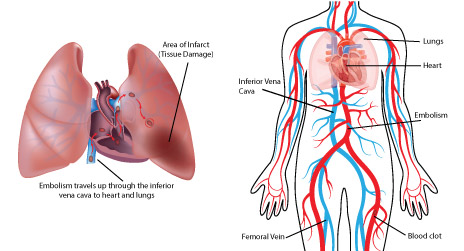
Professional drivers, especially those who drive long distances, may be at risk for developing Deep Vein Thrombosis, or DVT. This is a condition where a blood clot forms in a vein deep in the body, usually in the legs, and then dislodges and travels to the lungs, where it becomes stuck and causes a pulmonary embolism, which can be fatal. About 2 million Americans suffer from DVT each year. Nine out of 10 cases of PE (pulmonary embolism) are caused by blood clots that form in the legs and then travel to the lungs.
Sitting for long periods of time, as professional drivers often do, is one of the major risks for developing DVT. Some other risk factors for developing DVT include:
- Being overweight
- Smoking
- Being 60 years of age or older
- Having diminished blood flow in a deep vein as a result of injury, surgery or immobilization
- Trauma to the lower leg with or without surgery or casting
- Coexistence of an inherited blood-clotting disorder
- Presence of certain comorbid conditions, such as varicose veins
- Coexistence of cancer and associated treatment
- Use of contraceptive medications or hormonal therapy
- For females, being pregnant or in the first 6 – 8 weeks postpartum
The risk for DVT increases if a person has more than one of the above listed risk factors. The symptoms of DVT are related to obstruction of blood returning to the heart and causing a backup of blood in the leg. The symptoms of DVT typically include:
- Pain
- Leg tenderness
- Swelling
- Warmth
- Redness
Not all of these symptoms have to occur to indicate DVT. One, all or none of these symptoms may be present. The symptoms may also mimic an infection or cellulitis of the leg.
However, the risk of DVT can be minimized with several lifestyle changes. Drivers can combat DVT by losing excess weight, ceasing a smoking habit, exercising regularly and maintaining a healthy lifestyle of fresh, nutritious food and mindful movement.
Compression stockings, which can be purchased at drug stores, may also be helpful in preventing future DVT formation in those with a previous history of a clot. Check with your doctor for proper size and fit. Drivers should also wear loose, comfortable clothing and avoid short, tight socks if possible.
It is strongly recommended that drivers stop, get out and walk around as much as they can while on the road. A good general rule of thumb is to get out of your truck for five minutes every 1 – 2 hours. But don’t just walk around—take advantage of your mobility and stretch your legs and calves while you are out of the cab. The objective is to get and keep your blood flowing in your legs.
Drivers can also perform safe exercises while seated in their cab to get blood circulating within the legs. Bending and straightening your feet, legs and toes or pressing the balls of your feet against the floor every 30 minutes or so are all excellent ways to keep the blood flowing.
If you experience any of these warning signs, immediately seek medical attention:
- Sudden, unexplained shortness of breath
- Chest pain and trouble breathing or coughing
- Fainting, dizziness or lightheadedness
- Coughing up blood
- Rapid pulse/heart rate/breathing